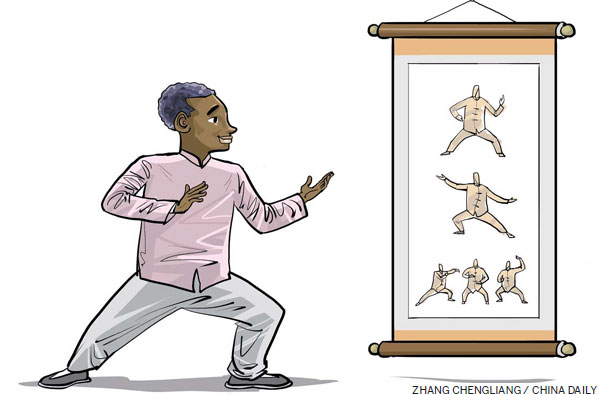BRICS can put Pretoria on growth path
Country can tap into bloc's bank to build critical infrastructure so that it can compete on global stage
South Africa's democracy is a mere 20 years old. During these two decades, the country, once in the quagmire of apartheid that saw it cut off from most of the world, has grown to be one of the powerhouses on the African continent.
But as the romanticism of the Nelson Mandela years of nation-building blurs into memory with each passing day, the real nitty-gritty of continuing to develop a country still battling to shake off the yoke of a violent, institutionalized racist past has provided political leaders and civil society both a raft of tough challenges and a unique set of opportunities.

That there is much left to do is without question - a sluggish economy, a depreciating currency, energy concerns, a high rate of unemployment, unacceptable crime levels, an aging state infrastructure - have all conspired to make for a populace demanding immediate action from the African National Congress-run government.
The criticism, some have argued, is too harsh, given that today more South Africans have a roof over their heads, access to water and electricity, a chance at a (decent) education and the promise of a better future borne out of hard work and self-determination.
The cost of freedom in South Africa has come with the demand to fulfill even greater aspirations and also to equally satisfy the expectations of the needs of every grouping of this multi-cultural society with its 11 official languages.
If the country is to become a serious player on a global level, however, the potential of the majority of its 54 million citizens needs to be realized or at least be given a chance to compete in a global economy driven ever increasingly by technological innovation.
Being part of the BRICS (Brazil, Russia, India, China and South Africa) group has already proven to be a game-changer for South Africa and can and will aid in that process.
But critical infrastructure failures persist. The country has been a victim of widespread electricity load-shedding for several months now.
Cash-strapped electricity parastatal Eskom, South Africa's main electricity supplier, will most likely call on the New Development Bank of the BRICS to fund the construction of power stations and transmission infrastructure.
It faces a more than 100 billion yuan ($16.1 billion) shortfall in its 168.5 billion yuan capital expenditure program, Eskom boss Brian Molefe has said.

Despite the obstacles, South Africa's most powerful business lobby groups, the Black Business Council, or BBC, and Business Unity South Africa, or BUSA, said they have noted that local companies were making inroads into BRICS markets.
The groups noted that with a combined GDP of $17 trillion, the BRICS nations have economic clout that rival that of the United States and may even surpass the US in the near future owing to the higher growth rates in some of the BRICS economies.
Some analysts believe that the cooperation and success of the BRICS countries will set the benchmark for developing nations and tilt the scales of the world economy more equally.
It also provides South Africa, which has the smallest economy among the five nations, a chance to learn from the experience within this construct.
An example of this is South African Deputy President Cyril Ramaphosa's recent visit to China, which was a vital step in the right direction in getting South Africa's state-owned utilities to serve the people more efficiently.
Ramaphosa was in the country "to study how Chinese state-owned enterprises are used to promote economic growth while addressing challenges of poverty and unemployment", the presidency said.
Ramaphosa also visited Qingdao, where he met the management of Haier and Hisense - which is a multinational white goods and an electronics manufacturer that expanded its existing operations in South Africa by establishing a manufacturing center in Atlantis, the Western Cape, where they employ around 600 locals.
Of the products manufactured in South Africa, around 40 percent are sold locally and the rest exported to other African countries.
The Haier Group has a sales office in South Africa and there are plans to set up a sales, research and development center and a manufacturing operation aimed at producing products for the South African and African markets.
Many in South Africa regard Ramaphosa as vital in growing the economy - he is a respected and successful businessman who has had experience sitting on the boards of global companies and therefore has the necessary heft to deal with industry leaders.
His visit further exemplifies the healthy relationship of China and South Africa, one that is as young as the African country's democracy, but which belies the deep economic and social ties fostered in this short time.
China is currently South Africa's largest trading partner. Total trade between the two countries experienced an upward trajectory since 2009, growing from 59 billion yuan to 135 billion yuan by the end of 2013.
This decreased to 130 billion yuan by the end of 2014.
Of Ramaphosa's visit, the South African government says it believes that the visit was an important step toward increasing trade with China.
It has already yielded one significant development - Air China will start direct flights to South Africa from Beijing on Oct 29, with three flights a week, after South African Airlines had canceled the route earlier this year.
Now it is up to the South African government to streamline its new visa processes and make it easier for Chinese tourists, who spent a staggering $160 billion on overseas goods last year, to visit our sunny shores.
Also, the World Travel Market Global Trends Report 2013 showed a shift in the global dominance of the travel trade away from the European and US markets, with visitor numbers from the BRICS nations rising dramatically
At a political level, South Africa's relationship with China is informed by the Comprehensive Strategic Partnership underpinned by the Beijing Declaration on the Establishment of a Comprehensive Strategic Partnership that includes all facets of relations between the two countries.
Around 300,000 Chinese people call South Africa home and are part and parcel of the social fabric - there are several Chinatown malls across the nine provinces and there are at least four Confucius Institutes at some of the leading tertiary education institutions in the country.
In an op-ed piece published in newspapers across South Africa this month, China's ambassador to South Africa, Tian Xuejun, summed up the relationship between the two nations thus: "China highly values its cooperation with South Africa and other members of BRICS. Our bilateral ties have never been as strong as today.
"During President (Jacob) Zuma' s successful visit to China last year, the two sides signed the Five-to-Ten Year Strategic Program for Cooperation, outlining a grand blueprint for deepened practical cooperation in various fields.
"This year marks the Year of China in South Africa, the Sixth Conference of the Forum on China-Africa Cooperation will also be held in South Africa, and our bilateral cooperation under the framework of BRICS will continue to inject fresh impetus into China-South Africa and China-Africa relations."
South Africa will no doubt continue to glean the best practices from the likes of the dragon economy.
But for it to be more than just a bit player in BRICS and, indeed, the world, it needs to get its house in order if it is to keep pace with the pack.
The author is the deputy editor of Cape Argus in Cape Town, South Africa. The views do not necessarily reflect those of China Daily.
(China Daily Africa Weekly 07/24/2015 page10)


















